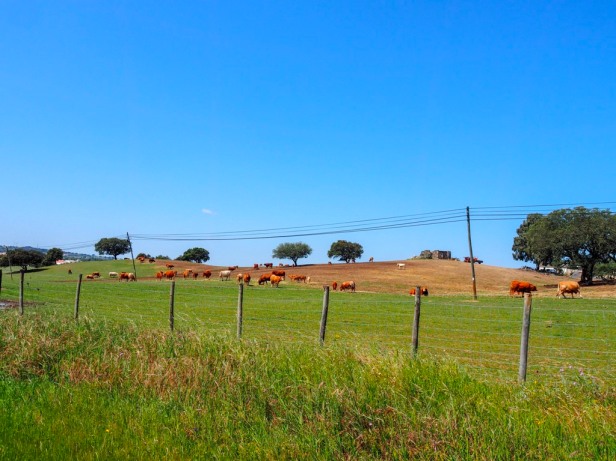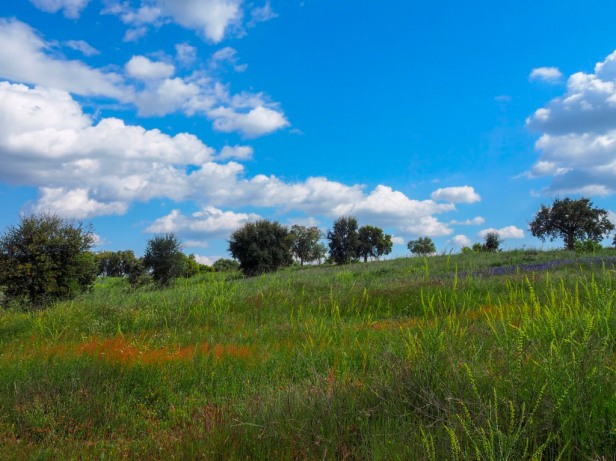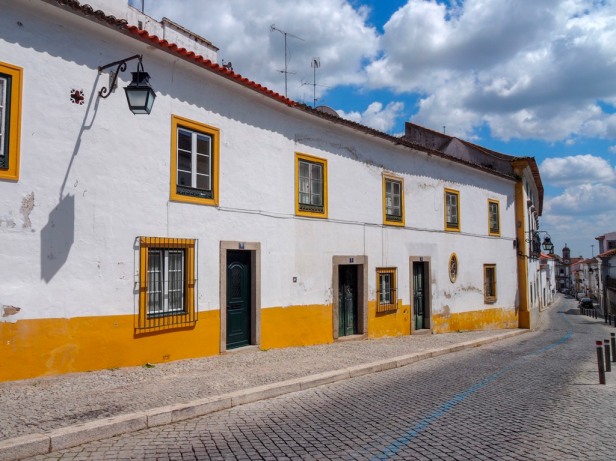If you haven’t added the Alentejo in southeast Portugal to your bucket list, I highly recommend you do immediately. It has everything you could wish for, from small ancient hilltop villages to huge open plains, vineyards, olive groves, cork trees, stunning beaches, awesome small luxury boutique hotels, great wines and the most delicious food.
Alentejo roughly covers around a third of Portugal but despite its size it remains an area that is overlooked by many, sandwiched between Lisbon and the Algarve.

Read on to discover six fantastic reasons to visit the Alentejo region, from the easy reach of the area to its beautiful landscape, historic walled hilltop towns and the exiting food and wines. And maybe the best of all, you will not run into large crowds doing the same!
How to get to Alentejo
Easy.
Whilst Alentejo is a region largely overlooked by tourists, it’s no big deal to reach the area.
It is only about an hour’s drive away from Lisbon.
There is a small however, though. It is a vast area but only around 5% of the Portuguese population lives here. This means, public transportation is limited.
Your best option will be renting a car.
Which is fine as it will give you a maximum of flexibility and driving in the Alentejo is really easy. There are a number of regional motorways connecting the various small towns and traffic will be light during most times of the year.
Driving into the small towns can be a bit more tricky as it means steep small cobble-stoned alleys, with parking likely the most difficult part.
In addition, when driving in Portugal, keep in mind that tart of the motorways are toll roads. The easiest way to deal with this is to include a toll option in your rental car package. That way, your car will be equipped with an electronic toll system and you simply drive through the ‘Via Verde’ lanes at toll points.
What is the Alentejo region like?
The beautiful landscape of Alentejo gets frequently compared to Provence and Tuscany, though it’s everything but. The region is much more untouched, featuring endless sweeping plains, large wheat fields, olive groves, cork oak and eucalyptus forests and lots of wildflowers along with sand dunes and huge white sandy beaches.



Large parts of the Alentejo are a nature reserve and while traversing the area you will quickly notice the absence of any industry except for agriculture.




The area around the Great Lake Alqueva, including the towns of Alandroal, Reguengos, Monsaraz, Mourão, Barrancos, Portel and Moura are part of the ‘dark sky Alqueva route’ – an area that is second to none for stargazing thanks to a very low rate of light pollution which makes the sky particularly dark. That said, light pollution due to the absence of large cities is low in most parts of Alentejo so you can enjoy star-lit dark nights also elsewhere.
Though I did not make it to the beach, the Alentejo also has a large coastline. It looks in parts quite similar to the beaches of the Algarve, in the south of Portugal. White sandy beaches with rugged towering cliffs. Just that here you will see only few other people.
Small hilltop towns, ancient ruins, fortresses and cathedrals
Throughout the Alentjeo, you will find numerous small picturesque hilltop towns waiting to be explored. Set foot into these beautiful whitewashed old towns and you will get the impression that time has passed by entirely.


What all of the gorgeous little towns have in common is that they are characterized by the typical white and yellow buildings, with some blue ones strewn in between, steep cobble-stone streets and amazing views over the surrounding areas. You will quickly notice that most also boost a strong Moorish influence in their historic architecture.


In addition, much like the rest of Portugal, the Alentejo is full of ancient ruins, fortresses, cathedrals and monasteries. In fact, even the tiniest town seems to have its own fortress.
There is hardly a town that does not offer some absolutely gorgeous corners and even the tiniest seems to have a historic church, cathedral or fortress. However, there are a few that definitely stand out.



Évora is the largest town of the Alentejo and indeed the region’s capital. Its origins are going back to ancient Roman times and for a certain time even used to be the home of the Portuguese kings.






The historic old town is a UNESCO World Heritage site since 1986 where you will find the remnants of a first-century Roman temple, a 12-century cathedral, a 15-th century convent and magnificent 16th-century facades clustered around narrow cobbled streets.
The cathedral, one of the most important Gothic cathedrals in Portugal, was originally built between 1186 and 1204 although it was restored and redesigned a couple of times. This is most evident inside where it spots various architectonical styles.


We visited the little town of Estremoz during one of the few days of bright sunshine and yet the number of tourists was almost negligible, and mainly limited to Portuguese visitors.




Towering over the small town is the Castelo de Estremoz. Just in front of the Castelo on the large square you will find a statue of Elizabeth of Aragon, who died at the castle in 1336.




Walk the streets around the castelo and you will be transported straight into the traditional rural lifestyle that has not changed much over time.
Sadly, we decided to forego a trip to Monsaraz (which would has taken us an hour either way) due to torrential rain on the day we had planned the trip. It was on my list for two reasons though and if you are in the area and would urge you to absolutely include it in your itinerary.
Firstly, this small historic hilltop fortress is one of the oldest settlements in Portugal. Today, it counts a population of only around 700. Now, imagine that!
Secondly, being located on the right margin of the Guadiana River from the hilltop castle you can expect enchanting views over the nearby Alqueva Dam.
Alentejo is home to an amazingly varied culinary landscape
Being also called the food basket of Portugal, the Alentejo region produces an amazing range of fresh produce thanks to the fertility of its soils and the favourite climate.
Among the region’s signature produce feature sheep’s cheese, black pork (the equivalent to the Spanish black pigs fed exclusively on acorns), wild boar, salt cod, olives, wild mushrooms and asparagus.
What you will be served will almost entirely come from the region – ‘farm to table’ is something the Alentejo has always done and does exceptionally good.
Most places will serve the traditional food in a straightforward and unfussy way. However, if you grave something more elaborate, there are now a number of Michelin-stared restaurants. Try Basilii at the Torre de Palma Wine Hotel near Monforte, or L’AND Restaurant at L’AND Vineyards in Montemor-o-Novo. There too you will get typical Alentejo food served with some international inspiration though.
Alentejo wineries are making outstanding wines
The Alentejo produces roughly half of Portugal’s wine, and the quality you will find here is amazing.
Indeed, there is a growing number of young wineries along traditional ones producing excellent medium to full-bodied red wines and increasingly white wines too.
Researching ahead of my trip to the Alentejo, I had a fairly long list of wineries to visit. Sadly, the rather unfriendly weather (untypical for the region but with the weather you never know) meant I changed my plans and only went to visit the wineries where I also had booked accommodation.


However, chatting to winery staff at the different places, I received a strong confirmation some of the places on my list to be very worth to visit. They included the wine shop of the Alentejo wine trail organisation (rota dos vinhos do Alentejo) directly in Évora where you can taste a large range of local wines. Others highly recommended were Herdade do Esporao, close to Monsaraz, one of the leading Alentejo wineries producing over forty grape varieties.
If you want to know more about Alentejo wines and wine tasting in the region, read my recent post here.
There is a growing number of stunning small luxury boutique hotels
Even though Alentejo is a region that does not see huge number of tourists, several stunning small boutique hotels were built over the past few years that will leave even the most demanding luxury traveller speechless.


Many of these hotels are directly connected to a local winery or will focus on highly wine-related experiences whilst offering lots of other activities too.
Check out my recent posts on some of these awesome hotels if you want to learn more about hotels in the Alentejo.
Have you been to Alentejo yet? Let me know about your experiences.

Great post 🙂
LikeLike
Thank you!
LikeLike
No problem 🙂 check out my blog when you get the chance 😄
LikeLike
Great pictures, loved the rooster!
LikeLike
Lovely post, thank you for sharing! We would love to visit Portugal in September and Alentejo sounds like an amazing escape from busy Lisbon 🤩
LikeLike
this is amazing post thank you for sharing information with us
LikeLike
Glad you liked it!
LikeLike